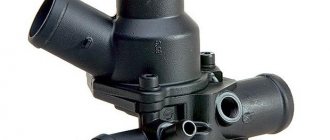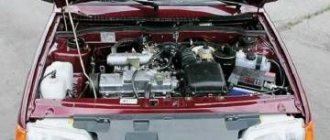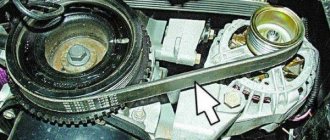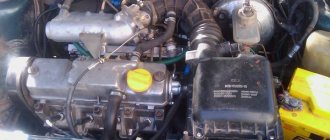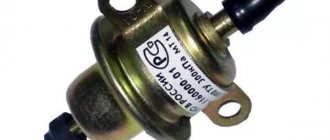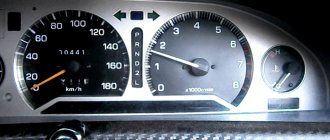Over the several years of production of the 2114 model, two types of ignition were installed on the car - contactless and electronic. If there are no problems with the second type, then with a contactless system there are problems. When there are problems with starting the engine and the stability of its operation, it will be useful to know how to set the ignition on a VAZ 2114. First, you need to know the differences between the two spark supply systems, and then carry out the repair yourself.
Useful video:
Ignition systems of the 8-valve injection VAZ-2114
You can determine the type of ignition by looking under the hood:
- If you find a breaker near the “heart” of your car (analogous to a distributor installed on contact systems), then your car belongs to the first series, and the ignition of the VAZ 2114 injector on it is non-contact, based on the breaker-distributor assembly. The ignition in such systems is set by turning the distributor degree by degree, and the results of the work depend on the experience of the performer and the availability of special equipment. So, with the help of a strobe light, the system can be debugged exactly as desired by the car owner.
- If this part is not present, then your car belongs to the representatives of the tenth family, equipped with an electronic ignition system. It is impossible to set this manually, and its operation is completely controlled by the ECU. At the same time, it is not completely unadjustable, because by connecting to an on-board computer, some of its parameters can be reconfigured to your taste, but there are only a few specialists capable of doing this correctly.
IMPORTANT! The electronic system in the VAZ 2114 is designed so that the owner does not have to maintain it, so if you do not plan to participate in racing competitions with your car, it is better not to mess with the software.
Ignition setting guide
One of the reasons is an incorrectly set ignition timing. To ensure that this problem no longer bothers you, you need to set this parameter - this can be done either with your own hands or at a service station. The crankshaft pulley has a special toothed disk designed to generate electromagnetic vibrations. Subsequently, the sensor converts these vibrations into a signal transmitted to the control unit. The latter, taking into account these parameters, in particular the position of the crankshaft, transmits an impulse to the module that distributes the spark between the spark plugs.
So, how to set the ignition yourself:
- First, remove the protective plastic cover from the timing device. Check the gap between the controller and the toothed disk - ideally it should be no more than 0.7 mm. If the gap is larger, this will result in a weak signal from the controller to the control unit.
- If the gap is normal, you need to start placing marks, but first you need to look at their compliance with the standard. This will allow you to ensure that the pulley on the crankshaft is not misaligned, otherwise the controller will also send incorrect information to the block. The mark on the flywheel must be aligned with the mark located on the transmission housing. To do this, the unit has a hatch where two risks are marked. In order for the marks to be aligned, it is necessary to rotate the crankshaft.
- The second mark is located on the oil pump pulley; you need to ensure that it coincides with the so-called tide on the cylinder block.
- As for the third mark, it is located on the camshaft drive gear pulley. It must be combined with the boss on the cylinder head, that is, the cover of the timing belt.
Causes of ignition problems
As mentioned earlier, in order to set the ignition in the electronic system you will have to go into the “brains”, there you can also check the functionality of the sensors, so they greatly influence the operation of the system, regardless of the type of ignition.
On the electronic type, the main causes of failures are:
- Incorrect information transmitted from sensors to the ECU. If the connection to the brain and diagnostics showed strange data coming from one or more control devices, it is necessary to use a “substitution”. The easiest way is to find a car with known good sensors, install them and double-check the results. Here you need to understand that you do not need a new one, but a working sensor, because factory defects are not excluded even on a new mechanism.
- The incoming voltage - correct from a technical point of view is 5V, but if due to a violation of the mechanical integrity of the wires or another problem with the car’s electronics, this voltage changes, the sensor readings will also change after it. If this happens, the ECU begins to adjust engine operation based on incorrect data, which leads to incorrect operation of the entire mechanism as a whole. To check this breakdown, you will need a known-good system of wires leading to the sensor or a donor car into which you can install your sensor and test the system for functionality.
- Broken ECU - if the previous two options did not give a visible result, and installing your sensor and wiring in a working machine does not change its performance, only this option remains. You can try to reflash the “brain” of the car, but due to its low cost, it is better to immediately buy a new ECU and install it on the car.
Before moving on to the radical measures proposed in the third option, it is worth additionally checking the correct location of the labels. In cars with contactless ignition, this is the ignition installation of the VAZ 2114, and for cars with an electronic system, debugging is important to check the synchronization of the injection system with the gas distribution mechanism.
Engine VAZ 2114
Introduction
The VAZ 2114 engine can be of various types. Over the entire period of time, AVTOVAZ installed three types of engines on the 14th model. They all have the same roots, but have been modernized and improved over time.
In this article we will talk about VAZ 2114 injection engines, namely about examples of engines installed on this model, their technical characteristics and maintenance periods.
VAZ 2114 engines
Below is a list of engines installed on the VAZ 2114 throughout the history of production.
- 1.5 liter 8 valve engine;
- 1.6 liter 8 valve engine;
- 1.6 liter 16 valve engine;
All engines have similar roots back to the distant 80s, namely with the 2108 engines. It was the eight engine that became the progenitor of all engines installed on modern VAZs.
This engine was distinguished by its reliability and maintainability.
Let's take a closer look at each of the engines.
Engine 2114 1.5 liter 8 valves
This engine was installed on the VAZ 2114 from the very beginning of production, namely from 2003 to 2007. It should be noted that the 1.5 liter engine was produced for some time in parallel with the 1.6 liter engine.
| Parameter | Meaning |
| Volume, (cm³) | 1496 |
| Power (hp) | 87 |
| Torque (Nm) | 115 |
| Injection | Injector |
| Number of cylinders | 4 |
| Ignition system | Ignition module |
| Fuel | AI-92 |
Engine Maintenance
The engine requires attention every 10-15 thousand mileage collimators. Upon reaching 10 thousand km. It is necessary to replace oils and filters, both oil and air.
Attention also needs to be paid to the timing belt. Although in this version the valve does not bend when it breaks, it is still advisable to carry out an inspection
On these models, the timing belt slips and is often eaten by rollers.
Engine 2114 1.6 liter 8 valves
This engine was installed on 2114 from 2003 to 2013. During its existence, the engine has undergone many changes. In 2010, cars with this engine began to be equipped with the E-GAZ system, that is, the accelerator pedal cable drive became electronic. AvtoVAZ engineers had to resort to this development due to the introduction of a new standard for the environmental safety of cars.
| Parameter | Meaning |
| Volume, (cm³) | 1596 |
| Power (hp) | 89 |
| Torque (Nm) | 125 |
| Injection | Injector |
| Number of cylinders | 4 |
| Ignition system | Ignition module |
| Fuel | AI-95 |
Engine Maintenance
This engine, like the previous one, requires attention every 10-15 thousand km. mileage It is necessary to replace oils and filters.
Engine 1.6 liter 16 valve
An engine with 16 valves was installed in a special series of VAZ 2114 cars called “SuperAuto”. This engine in the light body of the fourteenth model showed itself to be very worthy. The car has much improved dynamic characteristics compared to 8-valve engines.
| Parameter | Meaning |
| Volume, (cm³) | 1596 |
| Power (hp) | 92 |
| Torque (Nm) | 131 |
| Injection | Injector |
| Number of cylinders | 4 |
| Ignition system | Individual ignition coil for each cylinder |
| Fuel | AI-95 |
Engine Services
This engine, with 16 valves, received a serious flaw. When the timing belt breaks, the valves bend, which leads to very expensive repairs. Maintenance must be carried out every 10 thousand km. This includes changing oils and filters, as well as inspecting timing components for earlier detection of possible malfunctions.
Getting ready to adjust the ignition
In order to correctly set the ignition timing of the VAZ 2114 and carry out debugging, you need to prepare. The method described below does not require acrobatic agility from the owner and is quite feasible both in the uncomfortable and cramped environment of a garage and if the car enthusiast has a tummy.
IMPORTANT! Thorough preparation always speeds up the process of technical work significantly, regardless of what exactly needs to be repaired.
Preparation for debugging ignition marks is carried out as follows:
- The car is placed on a flat surface and placed on the handbrake.
- The second step is to remove the front right wheel, which will subsequently allow you to gain access to the gas distribution mechanism itself, which will speed up the work, make it convenient and easy, for this: a. unscrew the fastenings of our wheel and place a wheel chock under the diagonally opposite wheel (rear left); b. We lift the car with a jack, twist the wheel mounts completely and remove it.
- Finally, we need to remove the timing belt splash guard (if there is one, of course). By the way, you can not remove it entirely, but just unscrew the two lower fasteners, then it can be moved away without damaging it.
VAZ 2114 timing marks: do-it-yourself installation
How to correctly and accurately set the timing marks of a VAZ 2114 with an eight-valve engine will be discussed in this article. In fact, the engines on the 14th Lada model are installed the same as on the eights, nines, and tens. There are minor differences. Therefore, this guide will also be useful to owners of these models. Let's look at the most important questions that a motorist asks himself.
How often to change the timing belt and pulley?
There is no clear answer here. The fact is that all car mechanisms constantly wear out and are subjected to excessive loads. Therefore, you can pay attention to the recommendations of the manufacturer only if the car is new - up to 5-7 years. In this case, replacement is carried out every 55-60 thousand km. If the car is old, then reduce it by 15 thousand km. this figure is bold. The fact is that only engines with a volume of 1.5 liters will survive the break calmly and without consequences. But on eights, for example, they installed 1.3 engines, in which the valves bend.
Very often the timing belt on the VAZ 2114 and similar models wears out. This happens due to severe wear of the liquid pump. Its resource is no more than 90 thousand km. And then only if it is of high quality. What if you come across a defect or an obvious fake? Then it can break down even after half an hour of driving.
When the pump wears out, the roller eats rubber from the outside. And the more wear on the pump, the more visible the damage to the belt. So, the conclusion is this: change the timing kit (roller and belt) every 40-45 thousand km, install a new pump every second.
Timing marks VAZ 2114: install correctly
There is nothing difficult in the work - there are only three marks that you need to focus on. The preparation stage for replacement is as follows:
- Place the car on a flat surface and place chocks under the left rear wheel.
- Loosen the front right wheel bolts.
- Raise the right side with a jack.
- Completely unscrew the bolts and remove the wheel.
- If present, remove the protection.
- Remove the timing belt compartment protection cover - three bolts with a “10” socket head.
“If you do all the work carefully and fix the shafts, then there is no need to set marks” is a standard misconception, but it does exist if certain conditions are met. In most cases, this “trick” does not work; the shafts still need to be installed. Further work takes place in several stages:
- Remove the generator belt.
- Turn on the fifth gear and have an assistant sit behind the wheel and hold the brake pedal.
- Using a 19mm wrench, unscrew the crankshaft pulley bolt.
- Using a key set to “17”, loosen the tension roller.
- Remove the VAZ 2114 timing belt.
That's all, now you need to turn the crankshaft until the mark on the flywheel matches the slot in the bar. You observe this through a special window located in the clutch housing. If you make the adjustment yourself, first rotate the crankshaft and watch when the notch on the pulley points up. After this, make an accurate installation through the viewing window. And don’t forget about the camshaft - there is a mark on its pulley that aligns with the bar located on the cylinder head.
Having set the VAZ 2114 timing marks, you can install the belt. And don't forget to change the video! The old one will quickly become unusable and, at best, will begin to make unpleasant sounds. At worst, the belt will jam and break. Installation is carried out in reverse order. After tightening, it is extremely important to make sure that all marks match - turn the crankshaft several turns. Check the marks on the flywheel and camshaft. If they match, then you can put the wheel and casing in place.
Marks and direct adjustment
When the preparation is completed and the car is ready to work with it, you can begin to set the ignition marks of the VAZ 2114. The task of the procedure is to check the synchronism of the system (correlation of the camshaft, crankshaft and injection timing), with some nuances for the electronic system.
For electronic ignition systems, there is a small nuance - the need to check the distance from the master disk to the sensor. Normally, this distance should not exceed 0.7 mm, but should not be less than 0.5 mm. You can use a valve feeler gauge to check.
The further procedure for the electronic ignition system is as follows:
- We look into the mark hatch and align the gearbox housing mark with the flywheel mark by turning the crankshaft.
- We find the mark on the oil pump pulley and make sure it matches the tide of the cylinder block.
- Align the camshaft pulley mark with the head boss.
- The work is completed, to check the correct setting, check that the gap on the disk coincides with the tide of the cylinder block, and the twentieth tooth with the crankshaft position sensor. If everything matches, you have successfully completed the task.
On a car with contactless ignition, everything is even easier; you don’t have to remove the wheels, but you will need an assistant. It is necessary to find the compression stroke of the fourth cylinder. To do this, insert a rubber cone into the spark plug hole and turn the ratchet. Pushing out the cone will mean that the compression stroke has been found.
Having illuminated the spark plug hole, we align the longest mark of the cover with the mark of the pulley. We set the breaker to the appropriate clock and check the operation of the system according to the fourth point described above.
Useful video
You can find interesting information by watching the additional video below: https://www.youtube.com/watch?v=pNyBny-_HoQ
On a car with contactless ignition, everything is even easier; you don’t have to remove the wheels, but you will need an assistant. It is necessary to find the compression stroke of the fourth cylinder. To do this, insert a rubber cone into the spark plug hole and turn the ratchet. Pushing out the cone will mean that the compression stroke has been found.
Having illuminated the spark plug hole, we align the longest mark of the cover with the mark of the pulley. We set the breaker to the appropriate clock and check the operation of the system according to the fourth point described above.
How to set the ignition on a VAZ using marks
Almost all modifications of the VAZ-2114 and 2115 are equipped with engines with BSZ (non-contact electronic ignition). To make the setup, you need to:
- Unscrew the timing case fasteners and remove it.
Removing the timing case
- Adjust the gap from the crankshaft sensor (located near the generator pulley) to the gear disk. The permissible value is up to 0.7 mm.
Adjusting the gap from the crankshaft sensor to the gear disk
- If the distance is normal, check that the crankshaft pulley is not misaligned.
- To ensure that the marks on the flywheel align with those on the gearbox housing (can be seen on the hatch), the crankshaft must be rotated. It is convenient to do this by grasping the pulley mounting bolt.
Note! It is prohibited to turn the camshaft pulley itself.
Rotating the crankshaft pulley
- The mark on the cylinder block must align with that on the oil pump pulley. They should be adjusted.
- The last mark (on the camshaft pulley) should coincide with the other mark on the cylinder head.
Checking the marks on the camshaft and block
Having placed the marks on the VAZ model, you can see that the pistons of cylinders 1 and 4 are located at the dead center at the top, if everything is done correctly. In this case, the power unit operates correctly because the crankshaft sensor sends correct data to the ECU.
Ignition control
Electronic ignition control
How to set the ignition angle? On systems with electronic ignition control systems, this can be done using computer diagnostics that connect to the Electronic Control Unit (ECU) or the “brains” of the car. And there you can see how the engine operates in real time - what signals are received from the sensors, what engine speed, fuel consumption, injection timing, ignition timing and other input and output data.
Basically, you don’t need to change anything during operation unless you change the firmware. That is, if the machine somehow began to work incorrectly, then most likely there could be several reasons:
- An incorrect signal is received from the sensors; in this case, you can replace the supposed faulty sensor with a replacement one that is known to be working, and see if the result changes.
- The voltage in the network is incorrect and, accordingly, the sensors give the wrong signal. The input signal to the sensor is 5V, if this indicator is different, the ECU will receive incorrect input data and the engine will not be able to operate normally.
- The ECU is faulty. Quite often it happens that after going through everything possible, it turns out that your brains have flown. But don’t worry, they are inexpensive at VAZ.
Therefore, as such, the ignition is not set on injection machines, it is already built into the system, but it is worth checking whether the marks are set correctly.
Adjusting the ignition marks on the VAZ-2110 injector
When the engine is running, there are some phases that must work synchronously, the camshaft must coincide with the crankshaft, and the timing of fuel injection and ignition must correlate with them. Let's look at all this using the example of the VAZ-2110.
How to set the ignition on a VAZ 2110 injector
If the car doesn't start, it shoots, sneezes and everything goes wrong - the marks are not set somewhere and you need to sort it out.
On any car, the timing marks must be set perfectly, only then it will work normally. On the VAZ-2110, the crankshaft mark is located on the flywheel. You need to look through the inspection window on the gearbox housing; you can see the flywheel through it. It’s better to illuminate it with a flashlight, because it’s so easy to see.
The marks must match exactly. But... This may not happen. The fact is that when disassembling the engine, the flywheel can be placed on the other side, and then no one will need these marks. Let's consider other methods of how to deal with such a situation. To be honest, I have never set the timing belt to a mark on the flywheel; I don’t like this method.
A similar mark is present on the front belt pulley. Two points must coincide - one on the toothed pulley, and the second on the oil pump. If they coincide, it means that the pistons are at TDC of the 1st and 4th cylinders, and the crankshaft is set to its original position. It remains to do the same with the camshaft.
On single-shaft heads VAZ-2114, 2108, 2110, it is necessary to combine the boss on the sprocket and the protrusion on the rear timing belt cover.
For twin-shaft 16-valve engines, which are found on the VAZ-2112, the diagram looks a little different, the marks on the sprockets of both camshafts should look clearly upward, there are corresponding marks on the back cover with which they should coincide.
If all the marks match, great, the timing belt is ideal. Now all that remains is to check whether the crankshaft sensor is set correctly.
The crankshaft position sensor on the VAZ-2110 is installed in the front part of the engine; it reads readings from the sprocket, which is mounted on the pulley. This asterisk is placed on the key. And there are a few things to check here.
Since the pulley is placed on a key, a situation is possible when this seat breaks and the pulley is installed at a different angle, slightly turned out. From here, an incorrect signal will be sent to the crankshaft sensor, earlier or later than expected, and accordingly, the ignition will occur at an unknown time. It will be necessary to align the broken pulley more precisely, or change it along with the key.
Another problem may be that the crankshaft position sensor may be located too far from the pulley sprocket (maybe the sensor is slightly non-standard, or incorrectly installed), in which case the signal will be received incorrectly.
These are, perhaps, all the reasons that lead to ignition failure on a VAZ.
Checking the set ignition
To check the ignition on an 8-valve engine, an injector, you should prepare:
- Multimeter.
- Set of keys and screwdrivers.
- Pliers (necessarily with insulated handles).
Attention! Due to the lack of special equipment, the described method can only test the operation of the circuits. Diagnostics of the microprocessor part will not be available.
The process is:
- When the ignition is turned off, check how tightly the high voltage wires are seated and what contact is in the module.
- Remove the connector from the module, connect a multimeter (monitoring mode should be low AC) to pins C and B, make sure there is voltage. Check the coil (2nd and 4th contacts).
Checking the presence of power on the ignition module
- Check the functionality of high-voltage wires. Install a working spark plug in each cap in turn, attach one end to the block and crank the engine with the starter. The presence of a spark signals that everything is normal. Its absence on each wire means the module is faulty.
Checking high voltage wires
If you managed to set the ignition correctly on the VAZ model and this was confirmed by the test, but problems are still observed, you need to check the power system.
OPERATIONAL CHECK
To accurately determine whether it is time to change the high-voltage wires of the VAZ, you need to check their performance with a multimeter.
This operation will take you no more than 15 minutes:
- Turn off the ignition;
- We remove the wires: disconnect the first end from the ignition module, the second from the cylinder;
- We switch the tester to ohmmeter mode and connect the multimeter probes to the wire contacts.
If the high-voltage wires on the VAZ 2114 are in normal technical condition, the multimeter will show a resistance within the value indicated on the wire insulation; if the readings are different, the armored wires on the VAZ 2114 need to be replaced. The process must be repeated on each wire in turn.
If the test shows disappointing results, there is a possibility that the problem of increased resistance lies in oxidized contacts. In this case, you can try to revive the VVP by wiping the contacts with VD-40 or carburetor cleaning fluid.
Consequences of incorrectly setting timing marks
If the ignition is set incorrectly, the following negative aspects are possible:
- If the engine has 16 valves, then they become deformed or bent during operation, accumulating damage.
- The previous problem causes damage to the cylinder head.
- The guide bushings may also become unusable.
- Cracks may appear in other engine components.
Crack in the cylinder block
- The motor overheats.
- The engine piston mechanism can burn out.
- Oil residue may appear on the spark plugs.
Oil deposits on spark plugs
- The fuel mixture loses its ignition moment.
Note! If the engine has 8 valves, then the consequences are not so critical - traction disappears, the belt quickly wears out and breaks.
After repairs, the following factors most often indicate an incorrectly set ignition:
- The car accelerates worse.
- Frequent overheating of the motor.
- The craving became much worse.
How to set the ignition timing - Website about
Setting the ignition timing is one of the main settings of a car engine. Incorrectly set ignition (both in the direction of increasing the advance angle and in the direction of decreasing) immediately affects its operation for the worse. Therefore, you should pay special attention to this procedure, especially on front-wheel drive VAZ 2108, 2109, 21099 vehicles.
- Signs of incorrectly set ignition timing
- loss of power and throttle response
- failure when pressing the gas pedal
- unstable idle
- starting problems
- increased fuel consumption
- overheating, detonation, shots into the muffler or carburetor - this is not a complete list of such malfunctions.
It should be borne in mind that similar symptoms occur with an incorrectly adjusted or faulty carburetor, faulty valve mechanism, etc.
- Purpose of setting ignition timing
- Set the required ignition timing at which the main characteristics of the car engine - power, throttle response, idle speed, fuel consumption - will be normal.
- Tools for work
— Stroboscope (the simplest one, without a built-in tachometer, can be bought in a store for 200-300 rubles). A more advanced one, with a built-in tachometer, costs a little more.
— Tachometer (you can use the one built into the instrument panel, you can connect an external one (for example, an auto tester, a multimeter in tachometer mode), you can use your ear, if you have experience).
strobe and autotester
— Socket wrench or open-end wrench. Either a matching ratchet socket or an L-shaped wrench. Size 10.
- Preparatory work
- — Warm up the car engine to operating temperature (85-900).
- — Set the minimum idle speed (750-800 rpm).
Ignition system sensors and marks
For the ignition system to operate correctly, the computer needs to read the correct information from the sensors. Subsequently, this information will be processed in accordance with the fuel maps hardwired into the injector.
The main signal comes from the crankshaft sensor. This sensor shows what position the crankshaft is in at a given time and, based on it, calculates at what moment it is necessary to inject fuel, and at what moment this same fuel should be ignited, depending on the engine speed, which is also determined by this sensor.
1 – crankshaft drive disc; 2 – crankshaft position sensor; 3 – angle of rotation of the crankshaft; 4 – output signal of the crankshaft position sensor
And this is what a typical signal received by a computer from the crankshaft sensor looks like. Pay attention to 270° - this is like the zero point, showing the computer that the engine has completed a revolution and a new cycle begins. This is achieved due to the absence of a tooth on the crankshaft drive sprocket.


